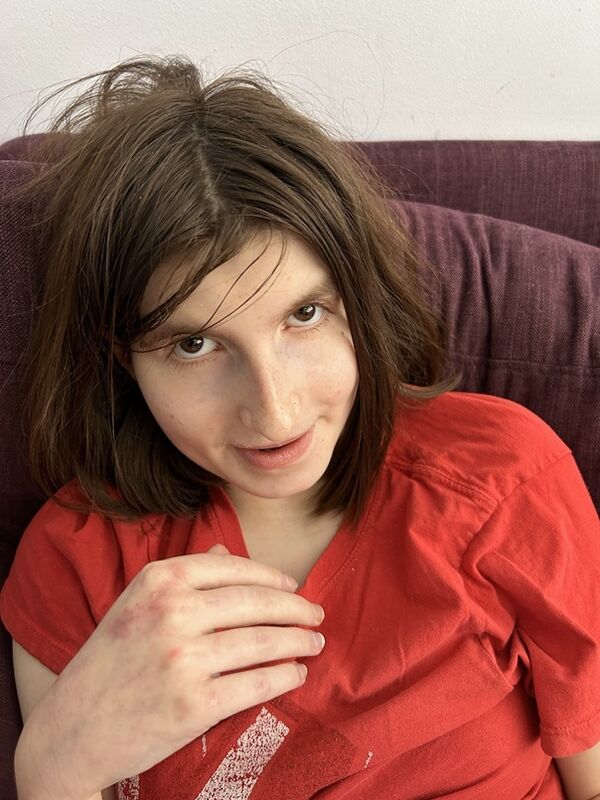Joey's story: DYRK1A syndrome
Joey is a seventeen-year-old who lives with her parents Shaun and Sarah. In 2020, several years after joining the 100,000 Genomes Project, she was diagnosed with DYRK1A syndrome – a rare chromosomal disorder.

About DYRK1A syndrome
Children with DYRK1A syndrome will almost always have some degree of developmental delay or learning difficulty. DYRK1A syndrome can be difficult to diagnose, although there are expected to be more diagnoses as genetic testing advances.
DYRK1A syndrome
is a rare condition caused by changes in the DYRK1A gene.
Other common symptoms
include feeding problems, a small head, and seizures.
Joey's story

Three months prior to Joey being born, Sarah’s midwife realised during checks that Joey was smaller than expected. That was the first time that Shaun and Sarah thought something might be wrong. Once Joey was born, it became apparent that she was nonverbal and had severe learning disabilities. She was also diagnosed with autism.
In the years after Joey made some progress, but it was very slow. Shaun says: “Physically, she grew and is surprisingly quick and strong considering the problems caused by her eating disorder. Her receptive language also exceeded her expressive language which caused her immense frustration and contributed to her challenging and at times violent behaviour. This was exacerbated by puberty.”
Joey and her family’s lives inspired the BBC comedy drama There She Goes, which both Shaun and Sarah were writers on. The show has helped raise awareness of people like Joey within mainstream culture.
Getting a diagnosis
Having spent years without knowing the exact cause of Joey’s condition, Shaun and Sarah received an invitation to participate in the 100,000 Genomes Project, which they accepted. Shaun remembers: “We talked it over and decided that we had nothing to lose.”
A few years later, Shaun and Sarah were unexpectedly asked to come in for a meeting by St George’s Hospital in London. Once there, they were told that in the analysis they had found a translocation, meaning an unusual rearrangement of chromosomes. This was followed by Joey being diagnosed with DYRK1A syndrome when she was 13 years old.
For Shaun and Sarah, finally having a diagnosis resulted in mixed emotions. Shaun explains: “I was thrilled about getting a diagnosis. It meant we could put a name to what Joey had and it helped me process everything. But my wife struggled with it as understandably it meant a confirmation that everything we had feared about Joey was correct and it brought back a lot of difficult memories.”
Living with DYRK1A syndrome
In practical terms, a diagnosis did not change a great deal as there is currently no treatment for DYRK1A syndrome. However, crucially it meant that Shaun and Sarah were able to connect with other parents whose children had similar conditions through the help of charities, namely Unique.
They found it helped to be able to talk to people in the same situation and be a part of a support network. They were able to get advice from other parents on aspects of Joey’s condition – for example her eating disorder.
Despite the challenges of Joey’s condition, she has also grown up to be a very strong and funny personality. Shaun says: “She brings joy to our family every single day. Everyone knows Joey and stops to talk to her, often dashing back into their house to get their cat as Joey loves it when they say “meow”. At her most recent parent’s evening at school, her teacher told us that all the staff adored her and she was described as having “a considerable presence” at the school.”
How whole genome sequencing can help those with DYRK1A syndrome
Shaun and Sarah now know that Joey has an extremely rare condition because of whole genome sequencing. The number of children in the world with DYRK1A syndrome is low, however there will be many more who simply have not received a diagnosis. Genetic testing is key to receiving one.
Whole genome sequencing is a fast-paced and ever-evolving landscape – it is continuously being reviewed using the latest technologies. As such, ongoing analysis by Genomics England means participants from the 100,000 Genome Project are still receiving diagnoses long after the project’s launch.
With a diagnosis and the accompanying sense of clarity, families have the choice to seek a support network from around the world if they want to and speak to others who may be able to help them. And while there is sadly no current treatment for DYRK1A syndrome, greater awareness of it means a greater possibility of a breakthrough.
Shaun says: “Everyone is different, but for us looking for help was a good thing for us to do and that was possible through genetic testing and knowing what Joey’s condition was.”